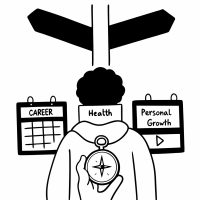
Question More, Action Knowledge.
Remember, at QMAK, we don’t just teach; we empower. We don’t just inform; we inspire. We don’t just question; we act. Become a Gold Member, and let’s unlock your child’s full potential, one question at a time.
![]() In a world filled with complex choices and an abundance of information, making effective decisions can be a daunting task. How do we know when we have enough information to make a well-informed choice without getting bogged down in analysis paralysis?
In a world filled with complex choices and an abundance of information, making effective decisions can be a daunting task. How do we know when we have enough information to make a well-informed choice without getting bogged down in analysis paralysis?
Enter Colin Powell’s 40-70% rule, a powerful mental model that can help us navigate the decision-making process with greater clarity and confidence.
Understanding and applying the 40-70% rule is crucial for making sound decisions, seizing opportunities, and achieving personal and professional success.
In this article, we’ll explore the essence of this rule, its applications in various domains, and strategies for incorporating it into our decision-making toolkit.
Colin Powell’s 40-70% rule suggests that when making decisions, we should aim to have no less than 40% and no more than 70% of the information we deem necessary. This sweet spot strikes a balance between having enough information to make an informed choice and avoiding the pitfalls of over-analysis and indecision.
The reasoning behind this rule is twofold:
By staying within the 40-70% range, we give ourselves permission to make decisions based on a solid foundation of knowledge while remaining agile and adaptable in the face of new information or changing circumstances.
One of the key insights from the 40/70 rule is the validation of our intuitive instincts when handled skillfully. Well before the analytical mind gets looped into endless scenarios, our subconscious processing has typically already surveyed the highest leverage factors. By staying present to these gut signals flashing from our vast cognitive databanks, we can confidently pilot toward purposeful action with agility.
The 40/70 rule highlights how a degree of being “wrong” is not just tolerable, but vital for growth. By intentionally proceeding into practice with just 40-70% of the picture, we embrace an inevitable learning curve as part of the mastery process. Each misconception or stumble becomes invaluable feedback folded into an iterative cycle of refining our approach.
Applying the 40-70% rule offers several key benefits for decision-makers:
![]() When working within the 40-70% range, we have room to leverage our intuition and judgment to fill in some of the information gaps. This allows us to make decisions that feel authentic and aligned with our values, while also remaining open to adapting our approach as we gain new insights or experience.
When working within the 40-70% range, we have room to leverage our intuition and judgment to fill in some of the information gaps. This allows us to make decisions that feel authentic and aligned with our values, while also remaining open to adapting our approach as we gain new insights or experience.
The beauty of the 40-70% rule lies in its versatility and broad applicability.
While it originated in the context of military decision-making, this mental model can be applied to various aspects of our lives:![]() Confidence: When taking on a new challenge or pursuing a goal, aim to have a 40-70% level of confidence in your abilities and understanding of the situation. This allows you to step outside your comfort zone and take calculated risks while avoiding the pitfalls of overconfidence or self-doubt.
Confidence: When taking on a new challenge or pursuing a goal, aim to have a 40-70% level of confidence in your abilities and understanding of the situation. This allows you to step outside your comfort zone and take calculated risks while avoiding the pitfalls of overconfidence or self-doubt.
![]() Planning: When developing a plan of action, strive for a 40-70% level of detail and completeness. This provides a clear roadmap while allowing for flexibility and adaptation as circumstances change or new information comes to light.
Planning: When developing a plan of action, strive for a 40-70% level of detail and completeness. This provides a clear roadmap while allowing for flexibility and adaptation as circumstances change or new information comes to light.
![]() Learning: When acquiring new knowledge or skills, aim to have a 40-70% level of mastery before applying them in real-world situations. This ensures a solid foundation of understanding while avoiding the trap of perfectionistic learning that can hinder progress and application.
Learning: When acquiring new knowledge or skills, aim to have a 40-70% level of mastery before applying them in real-world situations. This ensures a solid foundation of understanding while avoiding the trap of perfectionistic learning that can hinder progress and application.
To effectively apply the 40-70% rule, consider the following strategies:
Helping children understand and apply the 40-70% rule is a valuable gift that can set them up for success in decision-making throughout their lives.
Here are some strategies for introducing this concept in an age-appropriate way:
Use Relatable Examples![]() Present the 40-70% rule through examples that resonate with children’s experiences, such as choosing a game to play with friends or deciding what to build with blocks. Emphasize the importance of gathering enough information to make a good choice without getting stuck in indecision.
Present the 40-70% rule through examples that resonate with children’s experiences, such as choosing a game to play with friends or deciding what to build with blocks. Emphasize the importance of gathering enough information to make a good choice without getting stuck in indecision.
Encourage Experimentation![]() Create a safe environment where children can practice making decisions within the 40-70% range. Provide opportunities for them to gather information, weigh options, and take action, while also supporting them in adapting their approach based on the outcomes.
Create a safe environment where children can practice making decisions within the 40-70% range. Provide opportunities for them to gather information, weigh options, and take action, while also supporting them in adapting their approach based on the outcomes.
Model the Rule in Action![]() Children often learn best by observing the adults in their lives. When facing decisions, talk through your own process of gathering information, assessing risks and benefits, and making a choice within the 40-70% range. Highlight the value of balancing information with action.
Children often learn best by observing the adults in their lives. When facing decisions, talk through your own process of gathering information, assessing risks and benefits, and making a choice within the 40-70% range. Highlight the value of balancing information with action.
Celebrate the Learning Process![]() Help children embrace the idea that decisions made within the 40-70% range may not always lead to perfect outcomes, but that they provide valuable opportunities for learning and growth. Encourage a growth mindset that values progress over perfection.
Help children embrace the idea that decisions made within the 40-70% range may not always lead to perfect outcomes, but that they provide valuable opportunities for learning and growth. Encourage a growth mindset that values progress over perfection.
Promote Collaborative Learning and Calibration![]() Encourage children to workshop their activated knowledge together, sparking new revelations and reinforcing the resilience needed to iterate fearlessly. Group calibrations help hone skills for independently discerning the intuitive 40-70% strike zone, reducing wasted stagnation and amplifying focused progress.
Encourage children to workshop their activated knowledge together, sparking new revelations and reinforcing the resilience needed to iterate fearlessly. Group calibrations help hone skills for independently discerning the intuitive 40-70% strike zone, reducing wasted stagnation and amplifying focused progress.
Beyond its applications in decision-making, the 40-70% rule can also be a powerful tool for personal development and achieving our goals.
Here are some ways to leverage this mental model for personal growth:
Goal Setting

Skill Development

Relationship Building

Self-Reflection

Activating Knowledge into Impact

Colin Powell’s 40-70% rule offers a powerful framework for making effective decisions in a world of complexity and uncertainty. By aiming for a balance of information and action, we can navigate challenges with greater clarity, adaptability, and confidence.
Integrating the 40-70% rule into our decision-making processes is essential for personal and professional success. By teaching this mental model to children and applying it in our own lives, we foster a culture of informed action, continuous learning, and growth.
The most exceptional lives aren’t meticulously pre-planned, but iteratively crafted through intelligent action. By granting ourselves the gift of being confidently, progressively, and impactfully “wrong” through the 40/70 approach, we initiate ourselves into the profound wisdom of iterative mastery.
So let us embrace the power of the 40-70% rule, both in our individual journeys and in our roles as educators, mentors, and leaders. Let us strive for the sweet spot of informed decisiveness, trusting in our ability to make sound choices while remaining open to new insights and opportunities.
In doing so, we equip ourselves and the next generation with a valuable tool for navigating life’s complexities with wisdom, resilience, and the courage to act in the face of uncertainty. By mastering the art of decision-making within the 40-70% range, we unlock our potential for growth, achievement, and positive impact in an ever-changing world.
Objective: To introduce the concept of the 40-70% rule through the familiar Goldilocks story.
Objective: To practice gathering relevant information for decision-making within the 40-70% range.
Objective: To practice applying the 40-70% rule in simulated real-world scenarios.
Objective: To explore the iterative nature of decision-making and the value of learning from imperfect choices.
Objective: To apply the 40-70% rule in setting and pursuing personal goals.
Captain Phillips provides a gripping demonstration of Colin Powell’s 40-70 Rule through its portrayal of high-stakes decision-making at sea.
Based on true events, the film shows Captain Richard Phillips navigating life-or-death situations where waiting for complete information could be as dangerous as acting with too little.
As Phillips faces the Somali pirates, students witness how effective leadership often requires making crucial decisions with only partial clarity – somewhere between 40% and 70% of the information needed.
The film’s tense sequences illustrate why leaders can’t afford to wait for perfect certainty, yet must also avoid rash choices made with insufficient understanding.
Through Phillips’ calculated risks and strategic decisions, students learn how finding the sweet spot between analysis paralysis and impulsive action can mean the difference between success and failure in critical situations.
(Verse 1)
In the dance of decision-making, a rule to guide our way,
Colin Powell’s 40-70, a sweet spot to convey,
Not too little, not too much, just the right amount of know,
The 40-70 Tango, a rhythm to help us grow.
(Chorus)
The 40-70 Tango, a balance to embrace,
Informed decisions, swift action, intuition’s grace,
Adapting to the changes, as we learn and evolve,
The 40-70 Tango, a problem-solving resolve.
(Verse 2)
Less than 40, impulsive choices may arise,
More than 70, analysis paralysis, a demise,
But within the range, our gut instincts can guide,
A validation of intuition, a confidence to abide,
Embracing imperfections, as part of the learning curve,
The 40-70 Tango, a mastery to preserve.
(Bridge)
In goals and skills, relationships and reflection,
The 40-70 rule, a tool for introspection,
Activating knowledge, into impact and change,
The 40-70 Tango, a life-enhancing range.
(Chorus)
The 40-70 Tango, a balance to embrace,
Informed decisions, swift action, intuition’s grace,
Adapting to the changes, as we learn and evolve,
The 40-70 Tango, a problem-solving resolve.
(Verse 3)
Teach the children well, with examples they can grasp,
Encourage experimentation, and the learning process to clasp,
Model the rule in action, celebrate progress over perfection,
The 40-70 Tango, a lifelong connection.
(Outro)
In the complexities of life, a dance of uncertainty,
The 40-70 rule, a partner in clarity,
Navigating challenges, with wisdom and resilience,
Mastering decision-making, with iterative brilliance,
The 40-70 Tango, a rhythm to embrace,
A tool for growth, achievement, and positive change,
In an ever-changing world, a dance of grace.

Remember, at QMAK, we don’t just teach; we empower. We don’t just inform; we inspire. We don’t just question; we act. Become a Gold Member, and let’s unlock your child’s full potential, one question at a time.